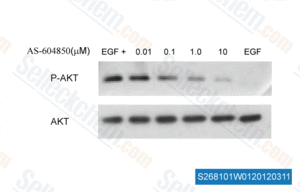|
Toll Free: (877) 796-6397 -- USA and Canada only -- |
Fax: +1-832-582-8590 Orders: +1-832-582-8158 |
Tech Support: +1-832-582-8158 Ext:3 Please provide your Order Number in the email. |
Technical Data
| Formula | C11H5F2NO4S |
|||
| Molecular Weight | 285.22 | CAS No. | 648449-76-7 | |
| Solubility (25°C)* | In vitro | DMSO | 57 mg/mL (199.84 mM) | |
| Ethanol | 5 mg/mL (17.53 mM) | |||
| Water | Insoluble | |||
|
* <1 mg/ml means slightly soluble or insoluble. * Please note that Selleck tests the solubility of all compounds in-house, and the actual solubility may differ slightly from published values. This is normal and is due to slight batch-to-batch variations. * Room temperature shipping (Stability testing shows this product can be shipped without any cooling measures.) |
||||
Preparing Stock Solutions
Biological Activity
| Description | AS-604850 is a selective, ATP-competitive PI3Kγ inhibitor with IC50 of 250 nM, over 80-fold selectivity for PI3Kγ than PI3Kδ/β, and 18-fold more selective for PI3Kγ than PI3Kα. | ||||
|---|---|---|---|---|---|
| Targets |
|
||||
| In vitro | AS-604850 is ATP-competitive PI3Kγ inhibitor with Ki values of 0.18 μM. AS-604850 is isoform selective inhibitor of PI3Kγ with over 30-fold selectivity for PI3Kδ and β, and 18-fold selectivity over PI3Kα. (PI3Kα: IC50 = 4.5 μM, PI3Kγ and β: IC50 > 20μM) AS-604850 is capable of inhibiting C5a-mediated PKB phosphorylation in RAW264 mouse macrophages with an IC50 with 10 μM. AS-604850 blocks MCP-1-mediated chemotaxis in Pik3cg +/+ monocytes in a concentration- dependent manner, with an IC50 of 21 mM, but dosn't affect chemotaxis in Pik3cg-/- cells, indicating that AS-604850 acts through PI3Kγ. [1] AS-604850 diminishes glycochenodeoxycholate (GCDC) induced Akt-phosphorylation and apoptosis in rat hepatocytes. AS-604850 diminishes bile salt-induced apoptosis in HepG2 Ntcp and Huh7-Ntcp cells. [2] AS604850 causes a concentration-dependent suppression of chemotactic responses of EoL-1 cells and blood eosinophils to platelet-activating factor (PAF). [3] | ||||
| In vivo | AS-604850 reduces RANTES-induced peritoneal neutrophil recruitment with a ED50 of 42.4 mg/kg. In the thioglycollate-induced peritonitis model, oral administration of 10 mg/kg AS-604850 results in a 31% reduction of neutrophil recruitment. [1] |
Protocol (from reference)
| Kinase Assay:[1] |
|
|---|---|
| Cell Assay:[2] |
|
| Animal Study:[1] |
|
References
|
Customer Product Validation

-
Data from [Data independently produced by J Biol Chem, 2014, 289(46), 32109-20]

-
, , Dr. Zhang of Tianjin Medical University

-
Data from [Data independently produced by , , Nature, 2017, 542(7642):489-493]
Selleck's AS-604850 has been cited by 12 publications
| GLP-1 and GIP receptors signal through distinct β-arrestin 2-dependent pathways to regulate pancreatic β cell function [ Cell Rep, 2023, 10.1016/j.celrep.2023.113326] | PubMed: 37897727 |
| DOCK2 and phosphoinositide-3 kinase δ mediate two complementary signaling pathways for CXCR5-dependent B cell migration [ Front Immunol, 2022, 13:982383] | PubMed: 36341455 |
| Repressing MYC by targeting BET synergizes with selective inhibition of PI3Kα against B cell lymphoma [ Cancer Lett, 2021, S0304-3835(21)00532-2] | PubMed: 34688842 |
| Retromer Complex and PI3K Complex II-Related Genes Mediate the Yeast (Saccharomyces cerevisiae) Sodium Metabisulfite Resistance Response [ Cells, 2021, 10(12)3512] | PubMed: 34944020 |
| Topical Application of the PI3Kβ-Selective Small Molecule Inhibitor TGX-221 Is an Effective Treatment Option for Experimental Epidermolysis Bullosa Acquisita [ Front Med (Lausanne), 2021, 8:713312] | PubMed: 34557502 |
| Topical Application of the PI3Kβ-Selective Small Molecule Inhibitor TGX-221 Is an Effective Treatment Option for Experimental Epidermolysis Bullosa Acquisita [ Front Med (Lausanne), 2021, 8:713312] | PubMed: 34557502 |
| Mussel-inspired injectable hydrogel and its counterpart for actuating proliferation and neuronal differentiation of retinal progenitor cells [ Biomaterials, 2019, 194:57-72] | PubMed: 30583149 |
| Recruitment of Vps34 PI3K and enrichment of PI3P phosphoinositide in the viral replication compartment is crucial for replication of a positive-strand RNA virus [ PLoS Pathog, 2019, 15(1):e1007530] | PubMed: 30625229 |
| PI3Kβ links integrin activation and PI(3,4)P2 production during invadopodial maturation. [ Mol Biol Cell, 2019, 30(18):2367-2376] | PubMed: 31318314 |
| Phosphatidylinositol 3-kinase δ Blockade Increases Genomic Instability in B Cells [ Nature, 2017, 23;542(7642):489-493.] | PubMed: 28199309 |
RETURN POLICY
Selleck Chemical’s Unconditional Return Policy ensures a smooth online shopping experience for our customers. If you are in any way unsatisfied with your purchase, you may return any item(s) within 7 days of receiving it. In the event of product quality issues, either protocol related or product related problems, you may return any item(s) within 365 days from the original purchase date. Please follow the instructions below when returning products.
SHIPPING AND STORAGE
Selleck products are transported at room temperature. If you receive the product at room temperature, please rest assured, the Selleck Quality Inspection Department has conducted experiments to verify that the normal temperature placement of one month will not affect the biological activity of powder products. After collecting, please store the product according to the requirements described in the datasheet. Most Selleck products are stable under the recommended conditions.
NOT FOR HUMAN, VETERINARY DIAGNOSTIC OR THERAPEUTIC USE.
